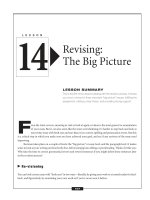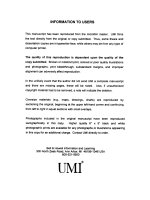Better Essays -Thesis Statements and the Drafting Process
Bạn đang xem bản rút gọn của tài liệu. Xem và tải ngay bản đầy đủ của tài liệu tại đây (106.27 KB, 12 trang )
T
he planning steps in Section 1 have led you to the next stage in the process, writing a rough draft. You
broke down the assignment, brainstormed ideas, focused your topic, developed a tentative thesis, and
sketched an outline. All of that work has provided a framework that you can now flesh out with sen-
tences and paragraphs that bring your ideas to your audience.
What Is Drafting?
To draft means to create a preliminary version or rough form of a text. Preliminary and rough are the key words.
Like brainstorming, drafting is most effective when you allow yourself to write imperfectly. Unless you’re writ-
ing a timed essay exam, such as for the SAT or ACT, your essay will take final shape after revising. (And even the
graders of those timed essays exams make it clear that they’re looking for a “polished rough draft,” not a perfect
piece of writing.) The point of drafting is to get your ideas on paper within the framework you created in the plan-
ning stages, but without the pressure of trying to get it exactly right.
LESSON
Thesis
Statements
and the
Drafting Process
LESSON SUMMARY
In this lesson, you’ll learn how to create a rough draft from your brain-
storming notes. You’ll also find out how to craft a strong thesis
statement.
8
65
Instead of staring at a blank piece of paper, at your outline, and then back at the paper, get writing. It’s espe-
cially important not to waste time trying to write an eloquent, attention-grabbing introduction. The best intro-
ductions are typically written after the body of the essay, when your ideas and the manner in which you reveal them
are on paper. That’s why the lesson on introductions doesn’t appear until after the lessons on writing good para-
graphs and providing support for your ideas and assertions.
Tips for the Drafting Process
Use the following guidelines to help keep your ideas flowing during the drafting stage:
■
Keep your thesis statement and assignment in front of you at all times. This will keep you focused on what
your essay needs to do.
■
Follow your outline, but be flexible. Don’t feel obligated to stick to your original plan if, as you’re writing,
you come up with a better order of paragraphs, or a new idea.
■
Save your drafts. Whether they’re on paper or on the computer, keep a copy of every version of your essay.
(That means, on the computer, you will need to make a copy of your draft into a new document before
revising.) You may find that an idea you thought you weren’t going to use will have a place in your essay
after all.
Practice 1
Briefly describe your typical writing process. How have you handled drafting in the past? What can you do to make
drafting more productive?
66
■
Don’t know what to say? Try one of the brainstorming techniques described in Lessons 3 and 4.
■
Don’t know where to begin? Create an outline. This will help you put your ideas in order and give you a
road map to follow.
■
Can’t think of the right way to start? Skip the introduction and instead jump into the body of your essay.
Once you know where you’re going and what you have to say, come back and create an effective
introduction.
Tips on Overcoming Writer’s Block
Drafting a Thesis Statement
While you don’t need to start with an introduction, you should have a thesis statement before you begin draft-
ing. Your thesis is the main idea of your essay—it succinctly reveals what you’re going to say. In Lesson 5, you
learned how to narrow your topic and formulate a tentative thesis. Now, you’ll either commit to that thesis, or revise
it into a workable thesis statement.
Here are a few more considerations:
1. A good thesis statement makes a strong, clear assertion that conveys your attitude about the subject.
No assertion: The School of Rock is about a substitute teacher.
Mild assertion: The School of Rock is an entertaining film about an influential substitute teacher.
Strong assertion: The School of Rock is about how a substitute teacher uses the transformative power of
rock and roll to help his students and himself.
2. A good thesis statement strikes the right balance between too broad and too narrow. It needs to be focused
enough to encompass just enough material to cover within the spatial confines of the essay, and narrow
enough to include enough material that can be supported by evidence.
Too broad: Animals have developed many strategies for survival.
Some focus: Animals have developed many strategies to protect themselves.
Focused: Many animals have developed physical properties that serve to protect them from
predators.
Too narrow: In “The Open Boat,” the repetition of “If I am going to be drowned” conveys Crane’s
theme of the indifference of nature.
Balanced: In “The Open Boat,” Crane uses several stylistic techniques to convey his theme of the
indifference of nature.
3. A thesis statement is not simply an announcement of the subject matter. You need to tell readers what you
are going to say about your subject.
Announcement: This paper will discuss some of the erroneous theories about the causes of the Great
Depression.
Thesis statement: The Great Depression was caused neither by the stock market crash of 1929 nor the
Smoot Hawley Tariff Act.
–THESIS STATEMENTS AND THE DRAFTING PROCESS–
67
Admissions officers typically spend about three to four minutes on each application essay. They’re not bound
by any rule that says they have to read each one from start to finish. The best way to guarantee a full read and
a better chance that your essay will help the admissions officer put your application in the “yes” pile is to hook
the reader, and only gradually reveal your subject. If you hand your subject, and your treatment of that subject,
to him or her in the opening paragraph, you’re providing a great reason to stop reading.
4. A thesis statement is not simply a question or list of questions. You still need to tell your reader what idea
you are going to develop in your essay (the answer to one or more of your questions).
Question: Why did Kafka choose to turn Gregor into a giant beetle?
Thesis statement: Gregor’s transformation into a giant beetle is a powerful symbol representing his indus-
trious nature and his role in his family both before and after his transformation.
5. A thesis statement is not simply a statement of fact. It must be an assertion that conveys your ideas about
the subject.
Statement of fact: There are many important similarities between the Perrault and Grimm versions of
Little Red Riding Hood.
Thesis statement: Both the Perrault and Grimm Brothers versions of Little Red Riding Hood reveal the
authors’ negative attitudes toward women.
Where Your Thesis Statement Belongs
While there is no rule that states exactly where you should place your thesis statement, because it helps your reader
by identifying your purpose, it should appear within the first or second paragraph of your essay. You want your
reader to know before they read too much what idea you will develop. Think of it this way: Imagine someone you
don’t know calls you on the phone. After she introduces herself, you expect that she’ll tell you why she’s calling.
What does she want? If she doesn’t tell you, you could become annoyed, suspicious, and even angry. You deserve
the courtesy of an explanation, and so does your reader. That explanation is your thesis statement.
While you should have a good working thesis statement to lead you through your draft, it’s important to
remember that even that statement is a draft. It’s your preliminary version, and as you write, you may find you
need to revise it. Be flexible. It makes more sense to revise it based on what you’ve written (if the writing works)
than to revise a decent draft to fit your thesis.
–THESIS STATEMENTS AND THE DRAFTING PROCESS–
68
The College Admissions Essay Difference
Practice 2
Revise and improve the following weak thesis statements.
1. In this essay, I will explain why I want to attend Briarwood College.
2. The death penalty is a controversial issue.
3. This novel had an important impact on my life.
4. What would the consequences of censorship on the Internet be?
In Short
Drafts are rough versions of your essay—a chance to get ideas on paper so you can shape them into an effective
essay. To get started, draft a thesis statement that makes a strong assertion about your subject. Be sure it’s focused
and avoid simply making an announcement, asking a question or stating a fact.
–THESIS STATEMENTS AND THE DRAFTING PROCESS–
69
Read a couple of essays and look for their thesis statements. How do the authors convey their main
idea? Where is the thesis statement located?
Skill Building until Next Time









